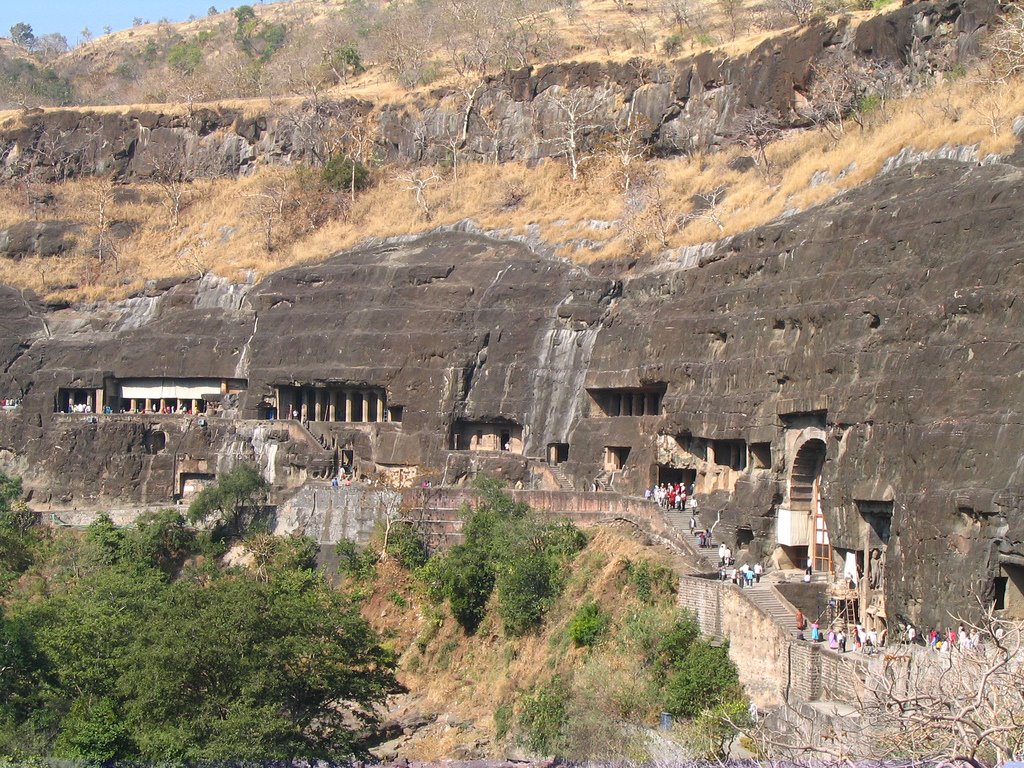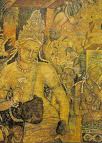
AURANGABAD DIVISION
AJANTA CAVES

AJANTA is world's greatest historical monument recognised by UNESCO located just 40kms from Jalgaon city of Maharashtra, India. There are 30 caves in Ajanta of which 9, 10, 19, 26 and 29 are chaitya-grihas and the rest are monasteries. These caves were discovered in AD 1819 and were built up in the earlier 2nd century BC-AD. Most of the paintings in Ajanta are right from 2nd century BC-AD and some of them about the fifth century AD and continued for the next two centuries. All paintings shows heavy religious influence and centre around Buddha, Bodhisattvas, incidents from the life of Buddha and the Jatakas. The paintings are executed on a ground of mud-plaster in the tempera technique.
Conjures before one's vision, a dream of beauty- of caves, hidden in the midst of a lonely glen with a streamlet flowing down below, caves that were scooped out into the heart of the rock so that the pious Buddhist monk, out on mission to spread the tenets of Buddhism could dwell and pray, caves that the followers of Lord Buddha, embellished with architectural details with a skilful command of the hammer over the chisel, with sculpture of highest craftsmanship and above all, with the paintings of infinite charm.
At Ajanta, the paintings on the walls, illustrate the events in the life of prince Gautama Buddha, the founder of Buddhism and in the more popular Jatakas stories pertaining to Buddha's previous incarnation. According to the older conceptions, the Buddha wrought many deeds of kindness and mercy in a long series of transmigration as a Bodhisattva, before achieving his final birth as the sage of sakyas
.
Incidentally they contain the scenes of semi-mythological history, the royal court and popular life of the ancient times, as told in romances and plays. Some pictures recall the Greek and Roman compositions and proportions, few late resemble to Chinese manners to some extent. But majority belongs to a phase, which is purely Indian, as they are found nowhere else. These monuments were constructed during two different periods of time separated by a long interval of four centuries. The older ones were the product of last to centuries before Christ and belong to Hinayana period of Buddhism in later part of 2nd century AD when Buddhism was divided into two sections, after the conduct of the fourth general council under another great king, Kanishka.
Dr. Babasaheb Ambedkar Marathwada University
Dr. Babasaheb Ambedkar Marathwada University was initiated by Pandit Jawaharlal Nehru on 23rd August in the year 1958. The university was formerly known as Marathwada University. Today, Dr. Babasaheb Ambedkar Marathwada University has achieved unique qualitative progress academically. The extensive campus of about seven hundred acres of land is covered by huge hills on the western side of Aurangabad caves and to its east side is Bibi Ka Makbura and picturesque sky-line. Some of its beautiful attractions are the history museum and the green botanical garden. The campus also has a badminton hall, swimming pool and gymnasium of Olympic level.
The university changed the name to Dr. Babasaheb Ambedkar Marathwada University on 14th January, 1994. After renaming out of seven districts in Marathwada, the college in four districts i.e. Aurangabad, Jalna, Beed and Osmanabad were affiliated to Dr. Babasaheb Ambedkar Marathwada University. Over the years, it has initiated 13 faculties which include arts, social sciences, science, commerce, fine arts, physical education, medicine, engineering, law education, ayurveda, homeopathy and management science. Currently 182 colleges are affiliated to this University.
Bibi Ka Maqbara
Bibi Ka Maqbara is a magnificent mausoleum, situated at a distance of approximately 5 km from the Aurangabad city of India. It entombs Rabia-ul-Daurani, alias Dilras Banu Begum, the wife of the Mughal Emperor Aurangzeb. The construction work on the mausoleum was started in the year 1651 and it took approximately 10 years to complete it. Prince Azam Shah, the son of Aurangzeb, got the tomb built in the memory of his mother. The main entrance door of Bibi ka Makbara is adorned with an inscription.
This inscription tells us that the tomb was designed by Ata-ullah, an architect, and constructed by Hanspat Rai, an engineer. The marble used in its construction is said to have been brought from the mines situated near the 'Pink City'. The design of the Bibi Ka Maqbara has largely been based on the Taj Mahal of Agra. However, it could not rival the magnificent 'Monument of Love' and was reduced to a poor imitation. Still, the mausoleum is today known as the 'Taj of Deccan'.
The reason for this is that, despite the fact that it could not be an adequate competitor for the Taj, it is still a magnificent monument. Bibi Ka Maqbara has been set amidst picturesque surroundings, with the mountain ranges providing the perfect backdrop. In the center of the north, east and western part of the enclosure wall of Bibi ka Makbara, one can find pillared pavilions. Its gardens follow the typical Mughal Char-Bagh pattern in their layout, adding to the splendor of the mausoleum.
The main entrance to it is provided by the gate, situated in the south and adorned with a brass plate having beautiful foliage designs. After crossing the entrance, one comes across a small tank and a screen wall that ultimately leads to the main structure. As one moves through the screened pathway, the series of fountains at the centre some into view - adding to the tranquility offered by the place. Supporting the base of Bibi Ka Maqbara is a square platform, with four minarets at its four corners. To the west of the tomb is a mosque, added much later.
The mortal remains of Rabia-ul-Daurani have been placed in a chamber, below the ground level. Surrounding them is an octagonal marble screen, which has been adorned with beautiful designs. The roof of the chamber coincides with the floor of the ground floor and stands pierced by an octagonal opening. This was done so as to ensure that the tomb remains visible from the ground level also. Adorning the top of the Bibi ka Makbara is a huge dome, pierced with trellis works and adorned with panels having floral designs.
Chand Minar
Chand Minar is at Daulatabad. It was built in the Turkish style in 1435 by Ala-ud-din Bahmani to celebrate his occupation of the fort. This minaret is an outstanding example of Islamic art.
This 30-metre high tower is divided into four storeys. It has 24 chambers and a small mosque at its base. It is covered with the Persian blue tiles that make the Chand Minar outstanding.
Path passes bastions; studded gates, a drawbridge and the Chini Mahal, where Abdul Hasan Tana Shah, the last King of Golconda, was imprisoned in 1687 for 13 years are the important attractions of the tomb. There is also a 6.6m long 'Kila Shikan' (Fort Breaker) iron cannon on the bastion.
There are 100-steps stairs that lead to the 'Baradari' (pavilion) at the end of the tunnel inside the citadel. This pavilion is said to be the palace of the Yadavi Queen and later Shah Jahan.
There is another cannon at the top with a ram's head on the butt. Around the muzzle of the cannon, it is inscribed in Persian as "Creator of storms". Aurangabad is well connected by air, rail and road with the important places within and beyond the state.
Daulatabad Fort
Daulatabad is situated around 13 kms away from Aurangabad. This place is known for its majestic fortress which was build in 12th century on top of a hill. The Daulatabad fort emerges dramatically over 600 ft above the Deccan plain. It is one of the world's best preserved forts of medieval times and also one of the few impregnable forts in Maharashtra with excellent architecture. The city was named Daulatabad 'The city of fortune', by Mohammed bin Tughluq, the sultan of Delhi.
Almost 800 years ago, Daulatabad, then called 'Devigiri' was a thriving city. It was founded by Bhillamraja of the Yadava dynasty in 1187 AD. Later, the fort of Daulatabad passed through the hands of several dynasties in the Deccan. Less than 150 years after the Yadava dynasty, Daulatabad also became the capital of India for a short period during the reign of Sultan Muhammad-bin-Tughluq, who gave the city its present name. But very soon the charm of this ancient city faded.
The Daulatabad fort is situated on top of a high hill, encircled by thick walls, spiked gates, steep slide ways and a deep trench. The fort has a coiled network of secret, quizzical and subsurface passages.
Situated on a hill and surrounded by a 40 ft. deep trench with mechanical drawbridges and crocodiles, this fascinating fort becomes impossible for intruders to approach. Along with these, a strong 5 kms long wall and complex series of defenses makes Daulatabad fort one the most secure forts.
The defense system of this fort was absolutely full proof with double and even triple rows of massive walls. This fortress was like a maze where the intruders were trapped. There was no way of conquering this majestic fort. The impregnable fort of Daulatabad was only conquered by treachery.
Pan Chakki
Panchakki otherwise known as the water mill was built during the early years of the 17th century. The mill used to grind grains for the pilgrims. It was so designed that it generated energy through water which was brought from a spring on a mountain.
These pipes are lined up at particular distances. To allow the water to flow through the pumps masonary pillars are erected. Water through the pipes flows with a force and it rises to a huge raised masonary pillar and from there it falls to make an attractive water fall.
Dnyaneshwar Garden, Paithan
the largest garden in Maharastrara sembling the Vrindavan Gardens of Bengluru situated on the banks of Nathsagar Lake. It is located in the ancient town of Paithan which is 50 km south of Aurangabad out of the 125 hectares, orchids cover 26 hectares, 28 hectares are laid out as parks and 15 hectares beautified with floriculture. Colourful flowerbeds, vast lawns and musical fountains are the attractions of the udyan. Ten plazas (raised platforms), twenty-two fountains are added features. More than a hundred thousand trees, in addition to the forty thousand fruit trees are the pride of the garden. There is also a nursery selling saplings and spices. A children's play area, swimming pool and boat rides make this spot ideal for weekend picnics. Evenings are the best time to visit Dnyaneshwar Udyan.
The Nathsagar Lake spread over 500 sq km is a sanctuary for migratory flamingoes and other birds. From the resthouse here, visitors can enjoy an exemplary view of the birds in their natural habitat. Male Masjit is near the garden, where the wedding ceremony between Emperor Akbar;sson, Danial, and the princess of Bijapur, took place.
is the nearest railroad access. Aurangabad Airport is 50 km from the town